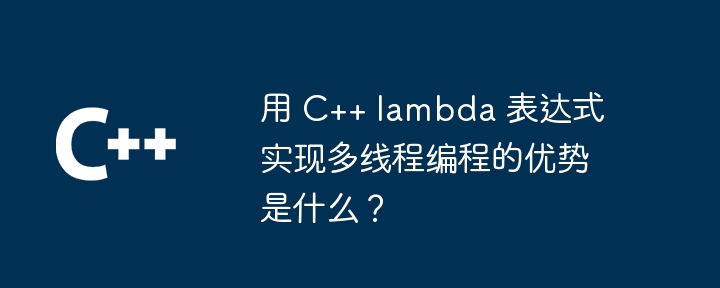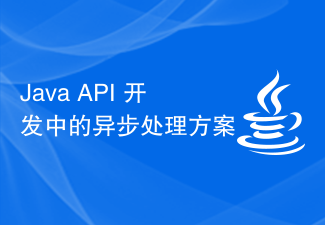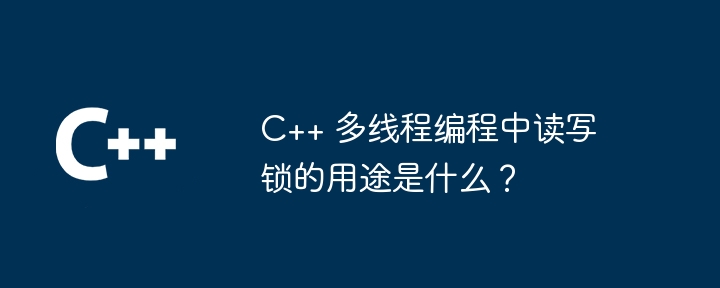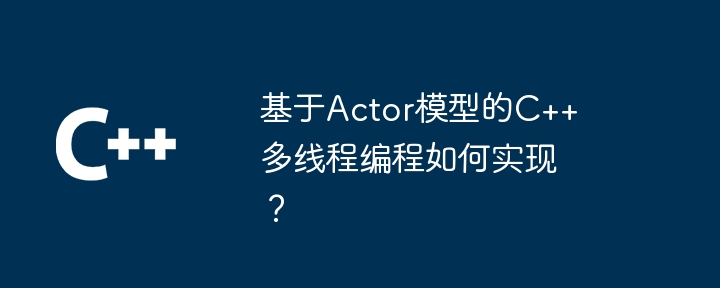 Java
Java javaTutorial
javaTutorial How to carry out multi-thread programming and concurrency control in Java development projects
How to carry out multi-thread programming and concurrency control in Java development projects
Title: How to carry out multi-thread programming and concurrency control in Java development projects
In today's Internet era, Java, as a multi-purpose programming language, is widely used in various development projects. In development projects, multi-threaded programming and concurrency control are problems that Java developers often encounter. This article will introduce how to perform multi-threaded programming and concurrency control in Java development projects, aiming to provide some guidance and suggestions for developers.
1. Understand the concept of multi-threaded programming
Multi-threaded programming refers to running multiple threads at the same time in a program, and these threads can perform tasks independently. Compared with single thread, multi-threading can improve the execution efficiency and response speed of the program. However, multi-threaded programming also brings some problems, such as thread safety and race conditions.
2. Ways to implement multi-threaded programming
In Java, there are many ways to implement multi-threaded programming. There are two most commonly used methods: inheriting the Thread class and implementing the Runnable interface. By inheriting the Thread class, you can create a new thread class and override the run() method in it to define the tasks performed by the thread. By implementing the Runnable interface, you need to create a class that implements the Runnable interface and instantiate a Thread object to perform the task.
3. Managing the life cycle of threads
When performing multi-threaded programming, you need to understand the life cycle of threads in order to be able to control their execution. Common thread states include new, ready, running, blocked and dead. By using the methods provided by Java, you can control the thread's transition from one state to another, as well as the execution order and time of the thread.
4. Dealing with thread safety issues
In multi-threaded programming, thread safety issues are a common problem. When multiple threads access and modify shared data simultaneously, race conditions and data inconsistencies may occur. In order to solve the thread safety problem, various methods can be adopted, such as using the synchronized keyword, using locks, using thread-safe data structures, etc.
5. Use concurrency control tools
Java provides some powerful concurrency control tools that can simplify multi-thread programming and deal with thread safety issues. The most commonly used tools include Lock, Condition, Semaphore, CyclicBarrier, Atomic Variable, etc. These tools can help developers achieve thread synchronization and collaboration.
6. Testing and debugging multi-threaded programs
When performing multi-threaded programming, testing and debugging are an indispensable step. Since the execution results of multi-threaded programs may be uncertain, testing is required to ensure the correctness of the program. During testing, you can use assertions and debugging tools to locate and resolve problems.
7. Optimize the performance of multi-threaded programs
In order to improve the performance of multi-threaded programs, some optimization methods can be adopted. These include reducing lock competition, reducing the number of thread switches, rationally utilizing caches and processors, etc. Through optimization, the running efficiency of the program can be improved, thereby improving the performance of the entire project.
8. Summary
Multi-thread programming and concurrency control are an important part of Java development projects. By understanding the concepts of multi-threaded programming, mastering the methods of multi-threaded programming, managing the life cycle of threads, dealing with thread safety issues, using concurrency control tools, testing and debugging multi-threaded programs, and optimizing the performance of multi-threaded programs, developers can better Good at multi-thread programming and concurrency control of Java development projects. Through continuous learning and practice, we can improve our technical level and contribute to the successful implementation of the project.
The above is the detailed content of How to carry out multi-thread programming and concurrency control in Java development projects. For more information, please follow other related articles on the PHP Chinese website!
 用 C++ lambda 表达式实现多线程编程的优势是什么?Apr 17, 2024 pm 05:24 PM
用 C++ lambda 表达式实现多线程编程的优势是什么?Apr 17, 2024 pm 05:24 PMlambda表达式在C++多线程编程中的优势包括:简洁性、灵活性、易于传参和并行性。实战案例:使用lambda表达式创建多线程,在不同线程中打印线程ID,展示了该方法的简洁和易用性。
 Java API 开发中的异步处理方案Jun 18, 2023 am 10:11 AM
Java API 开发中的异步处理方案Jun 18, 2023 am 10:11 AM随着Java技术的不断发展,JavaAPI已经成为许多企业开发的主流方案之一。在JavaAPI开发过程中,常常需要对大量的请求和数据进行处理,但是传统的同步处理方式无法满足高并发、高吞吐量的需求。因此,异步处理成为了JavaAPI开发中的重要解决方案之一。本文将介绍JavaAPI开发中常用的异步处理方案及其使用方法。一、Java异
 C#开发注意事项:多线程编程与并发控制Nov 22, 2023 pm 01:26 PM
C#开发注意事项:多线程编程与并发控制Nov 22, 2023 pm 01:26 PM在C#开发中,面对不断增长的数据和任务,多线程编程和并发控制显得尤为重要。本文将从多线程编程和并发控制两个方面,为大家介绍一些在C#开发中需要注意的事项。一、多线程编程多线程编程是一种利用CPU多核心资源提高程序效率的技术。在C#程序中,多线程编程可以使用Thread类、ThreadPool类、Task类以及Async/Await等方式实现。但在进行多线程编
 C++ 多线程编程中读写锁的用途是什么?Jun 03, 2024 am 11:16 AM
C++ 多线程编程中读写锁的用途是什么?Jun 03, 2024 am 11:16 AM多线程中,读写锁允许多个线程同时读取数据,但只允许一个线程写入数据,以提高并发性和数据一致性。C++中的std::shared_mutex类提供了以下成员函数:lock():获取写入访问权限,当没有其他线程持有读取或写入锁时成功。lock_read():获取读取访问权限,可与其他读取锁或写入锁同时持有。unlock():释放写入访问权限。unlock_shared():释放读取访问权限。
 基于Actor模型的C++多线程编程如何实现?Jun 05, 2024 am 11:49 AM
基于Actor模型的C++多线程编程如何实现?Jun 05, 2024 am 11:49 AM基于Actor模型的C++多线程编程实现:创建表示独立实体的Actor类。设置存储消息的消息队列。定义Actor从队列接收并处理消息的方法。创建Actor对象,启动线程来运行它们。通过消息队列发送消息到Actor。这种方法提供了高并发性、可扩展性和隔离性,非常适合需要处理大量并行任务的应用程序。
 Redis实现分布式事务的并发控制详解Jun 21, 2023 pm 02:05 PM
Redis实现分布式事务的并发控制详解Jun 21, 2023 pm 02:05 PM随着互联网应用的发展,分布式系统成为了一个不可避免的趋势。在分布式系统中,多个服务之间需要进行数据交互,而这些数据交互可以被看作是一系列的事务。当多个服务同时对事务进行操作时,就需要进行并发控制。Redis是一个高性能的键值数据库,广泛应用于分布式系统中。它支持多种数据结构和命令,包括事务和监视,这让它成为了分布式系统中并发控制的一个好选择。本文将详细介绍R
 Java语言中的并发编程技术介绍Jun 10, 2023 pm 11:11 PM
Java语言中的并发编程技术介绍Jun 10, 2023 pm 11:11 PMJava是一种广泛应用于开发各种程序的编程语言,它的并发编程技术受到广泛关注。随着多核处理器的普及和Web应用程序的开发,Java语言中并发编程的重要性愈加凸显。本文旨在介绍Java语言中的并发编程技术。1.什么是并发编程在计算机科学中,并发是指两个或多个独立的计算进程同时存在于计算机系统中的现象。并发编程是指设计和实现并发系统的程序技术,目的是解决多个任务
 如何在PHP中使用多线程编程?May 12, 2023 am 08:39 AM
如何在PHP中使用多线程编程?May 12, 2023 am 08:39 AM随着Web应用程序变得越来越庞大和复杂,传统的单线程PHP开发模式不再适用于高并发处理。在这种情况下,使用多线程技术可以提高Web应用程序处理并发请求的能力。本文将介绍如何在PHP中使用多线程编程。一、多线程概述多线程编程是指在一个进程中并发执行多个线程,每个线程都能单独访问进程中的共享内存和资源。多线程技术可以提高CPU和内存的使用效率,同时可以处理更多的


Hot AI Tools

Undresser.AI Undress
AI-powered app for creating realistic nude photos

AI Clothes Remover
Online AI tool for removing clothes from photos.

Undress AI Tool
Undress images for free

Clothoff.io
AI clothes remover

AI Hentai Generator
Generate AI Hentai for free.

Hot Article

Hot Tools

SublimeText3 Linux new version
SublimeText3 Linux latest version

EditPlus Chinese cracked version
Small size, syntax highlighting, does not support code prompt function

SublimeText3 Chinese version
Chinese version, very easy to use

Notepad++7.3.1
Easy-to-use and free code editor

Dreamweaver Mac version
Visual web development tools





